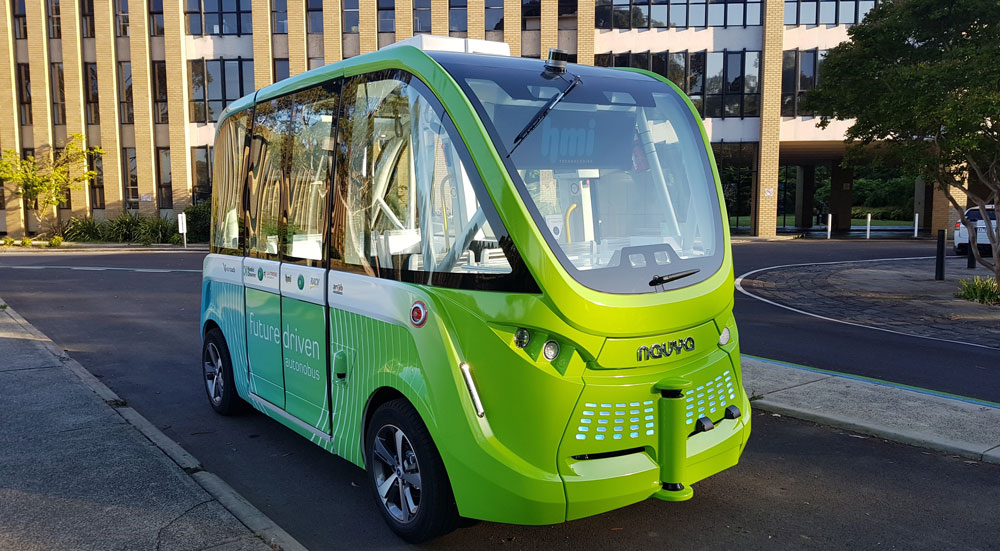Trials of Automated Shuttles

A 2020 NTC report on lessons learned from Automated Vehicle (AV) trials noted that there have been 22 trials of automated shuttles in Australia. There have also been similar trials in New Zealand. This database entry seeks to provide summarised information on some key lessons learned from these trials.
Automated shuttles are electric vehicles with no steering wheel that can operate at SAE level 4 (highly automated driving). Trials up until the end of 2020 had all used safety drivers or chaperones who can take back control of the vehicle with a joystick controller and this had generally been specified as a condition of their trial exemption or permit. The maximum passenger capacity of these shuttles ranges up to 15 people and their maximum speed is approximately 25 km/h.
Start and end dates: Start August 2016 (first on-road trial), trials continue
Included technologies
- Automated driving and driver support: highly automated driving
Project stages
- Demonstration or Proof of Concept
- Testing for specific performance
Included locations
- Urban low traffic / low speed roads
- Urban non-road
- Private facilities
Benefits directly sought by the project
- Increase knowledge and experience of the technology
- Increase public support to assist deployment and adoption
- Commercial return - product / service development
Project scale
- Each trial has included between one and three vehicles
Further details on included technologies
Australian trials up to the end of 2020 have used vehicles developed by EasyMile (11 trials), Navya (9 trials), Aurrigo (2 trials) and Local Motors (1 trial). New Zealand trials up to the end of 2020 have used vehicles developed by Navya (Christchurch) and Ohmio (Christchurch and Auckland).
Across the various trials of automated shuttles, there were some commonly shared objectives. These included:
- Increased understanding for trial partners and the broader sector about the potential impact and opportunities of the technology, including:
- Potential for (and challenges and opportunities in achieving) safety benefits from highly automated driving
- Implications for offering transport solution use cases with shuttles, such as first-mile and last-mile connections to other transport modes
- Implications for using automated shuttles (and similar) to serve disadvantaged users such as those with accessibility impairments
- Nature of interactions with other road users
- Nature of interactions with road infrastructure.
- Increased community awareness and acceptance of the technology, including in some projects, to support broader communication to the community that government and industry are investigating and preparing for future transport solutions that may meet their needs.
- Support development of capability for potential future involvement of government and industry trial partners in further automated driving pilots or deployments.
Lessons learned to inform the conduct of trials
- Evaluation processes varied significantly between trials, including:
- How clearly the objectives to be assessed were determined and stated up-front
- The method used to evaluate performance relative to any such objectives
- The extent to which any results were made publicly available following completion of the trial.
- The 2020 NTC report on lessons learned from Automated Vehicle (AV) trials recommends consideration of a standardised evaluation framework to allow greater comparability between trials. There appears to have been some overlap between the various trials conducted and clearer statement and sharing up-front of objectives may assist to reduce future overlap.
- Some (but not all) Australian trial projects have reported challenges with respect to the importation of vehicles as the shuttle vehicles do not meet current vehicle standards and a discretionary approval pathway be followed.
- Many trials conducted in Australia have depended on funding support from a government source and these trials would not have occurred had no government funding support been available.
- Risk assessments for trials have often contributed to the selection of lower complexity environments for the conduct of the trials, assisting the practicality of conducting the trials but reducing the potential for lessons to be learned in more complex or challenging environments.
Lessons learned that inform future technology deployments
- In those trials that explored user or community sentiment of automated shuttles and automated driving, it was generally reported that sentiment improved following direct exposure to the automated driving technology.
- The trials have assisted the understanding by government and local industry of the maturity of the automated driving technology and both the nature and scale of the gaps still needing to be addressed prior to readiness for commercial deployment.
- The risk-taking behaviour of other road users (pedestrians, cyclists and drivers) around the automated shuttles was noted on multiple trials to present a challenge, with some suggestions that the level of risk-taking around the shuttles may be higher than the norms on public roads.
Links to project lessons learned and / or benefit assessment reports
2020 NTC report on lessons learned from Automated Vehicle (AV) trials
Report on the Autonobus project at La Trobe University
RAC WA 12-month summary of post-ride feedback
Links to any other supporting project reports
RAC WA information and reports on the Intellibus
TfNSW news article: Driverless shuttle 'Ardi' says goodbye to Armidale
Last updated: May 2021.
